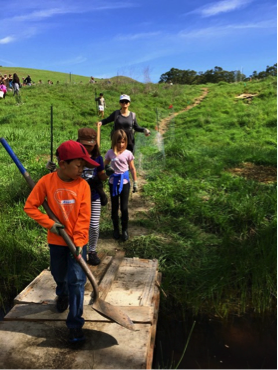Barlow and Stone JSE March 2017_Future Casting Issue PDF [2]
“We need citizens,” writes David W. Orr, “who know how the world works as a physical system and who understand how, when, and where to intervene in complex systems to cause the right kind of change at the right time…. We need people who know and love this place and see it whole and see it for what it can be.”[i] [3]
Future casting for us begins with going back — to the real basics, to understanding our place and the people who sustained themselves here for hundreds of years, engaging in real-world problem solving in pursuit of “the right kind of change at the right time.”
Knowing our place well entails acquiring understandings that its inhabitants once gained by living intimately with it.[ii] [4] What species of plants and animals live in the region? What webs of interdependence connect them? Which species are native, which migrate through, which are invasive and pose threats to native species? Which are indicators of this place’s environmental health? What are those indicators telling us?
How does the water we drink get from precipitation to our taps, and who maintains that system? Is the availability of sufficient safe drinking water threatened or susceptible to disruption? How is our place different from season to season? Has our climate changed in the last 30 or 40 years? What is the evidence? If it has changed, must we change to adapt to it?
Knowing our place means learning from the people who have inhabited it. Did indigenous peoples once practice bioregionally self-sufficient living here? How long ago? How did they provision themselves, using what techniques? If they lived sustainably in this place for long periods, how did they organize their communities, make decisions, or resolve conflicts? What happened to them? How have successive groups of people altered the land?
What is distinctive about this place today? What brought its inhabitants or their ancestors here? Did they carry with them traditions that remain important in their families or the larger community? How do long-time residents regard changes that they have seen during their lifetimes? Are today’s residents deeply rooted, or do they see this as a temporary stopping place on their way somewhere else?
Future education to help foster what Orr calls “love for this place and seeing it whole and for what it can be” may require creating new opportunities for immersion, especially in the natural world, from which many students have become disconnected. Occasional activities or field trips won’t do; deep and lasting understanding, in our experience, arises from exposure that is extensive and continuous over time. A few examples for the future: Students may “adopt” sectors of land, possibly live on and care for them, monitor and measure physical changes and ecological succession from year to year. Or they may simply pay attention and make a record of what they notice as their ability to observe becomes more sophisticated and they develop what Howard Gardner calls “naturalistic intelligence.”[iii] [5] Habitat restorations can be structured as long-term projects, such as testing which species will thrive best under changing climate conditions. Older students could be responsible for mentoring younger students, introducing them to the special places that they know and love.
Knowing our place will also emerge from recognizing present and potential obstacles to sustainable living and connecting with the people and organizations who are responding to them. Sustainability is a community practice.[iv] [6] Knowing how, when, and where to intervene in complex systems, and acquiring the skills to intervene effectively will not happen on the sidelines, but by engaging with communities that are grappling with issues and challenges.
Longer engagements may mark the curriculum of the future — work-study for all, not just to be ready for a job, but prepared to contribute as a citizen; semesters devoted to helping draft and then garner approval for a city food policy or a climate action plan; a junior year on a farm or interning with a community organization instead of a junior year abroad; producing a film that tells the stories of everyone whose labor brings food from a seed in the ground to lunch in the cafeteria; mapping the upstream sources and downstream consequences of community decisions about energy, resources, and waste.
Our futures will not be lived in Utopia — literally, “no place” — but in specific places with particular geographies, climates, histories, and living webs of relationship. Helping students develop the knowledge and skills to live sustainably wherever the future may find them can begin by offering them opportunities and tools for understanding and caring well for one place, their home place today.
End Notes
[i] [7] David W. Orr, Dangerous Years: Climate Change, the Long Emergency, and the Way Forward (New Haven and London: Yale University Press, 2016), p. 227.
[ii] [8] Questions to ask to check for understanding of place may be found in various “biogeographical quizzes,” beginning with “Where You At — A Bioregional Quiz,” by Leonard Charles, Jim Dodge, Lynn Milliman, and Victoria Stockley in the Winter 1981 CoEvolution Quarterly and adapted, refined, and expanded by a number of people since then. See, for instance, a version from 2013 by Tina Fields at https://indigenize.wordpress.com/2013/03/21/bioregional-quiz/ [9].
[iii] [10] Howard Gardner, Intelligence Reframed: Multiple Intelligences for the 21st Century (New York: Basic Books, 1999), pp. 48–52.
[iv] [11] Michael K. Stone/Center for Ecoliteracy, Smart by Nature (Healdsburg, CA: Watershed Media, 2009), pp. 11 ff.
